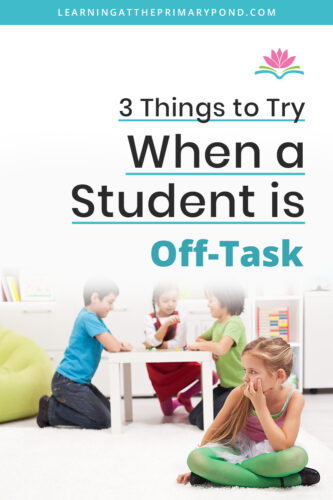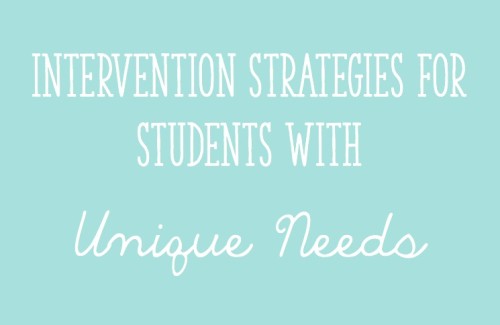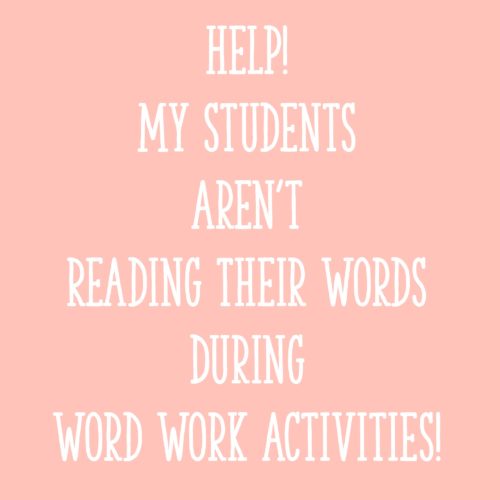Imagine you’ve worked really hard at planning and prepping a lesson, only to look around the room and spot a student that is off-task. In this moment, you could feel frustrated, annoyed, and flustered… but what should you actually do to remedy the situation?
First, I think it’s important to define what “off-task” is. Off-task behaviors are those that don’t align with the classroom or school goals. Here are a few examples of off-task behavior:
- playing with or tapping a pencil or other school supply
- talking to another classmate
- facing the wrong direction (i.e. towards the back of the classroom)
- head down on the desk
- staring off into dreamland…
In many cases, a student may not even realize they are off-task or doing the “incorrect” thing. This is why remaining calm and having some techniques to use is so crucial! Don’t take anything personally (even if you’ve worked super, super hard to prep an engaging activity!) because kids rely on you to help steer them in the right direction! 🙂
In this blog, I’m going to go through some questions you should ask yourself to gather more information about the off-task behavior. I’ll then provide three specific techniques you can try with your Kindergarten, first grade, or second grade students when someone is off-task.

3 Techniques to Try with an Off-Task Student
Before we dive in, it’s very important to consider why a student (or students) is off-task. Considering the “why” may help to stop this off-task behavior from becoming a habit.
Sometimes, a child will be off-task just momentarily; they’re taking a quick break! If you pause and give them a moment, they may very well correct themselves. However, if you see the behavior persisting, here are some reflection questions you can ask yourself:
- Is the task they’re being asked to do too difficult for them?
- Is the task they’re being asked to do too easy for them?
- Were the directions of what’s expected clear? In other words, are students clear on what “on-task” behavior looks like?
- Has there been too much time given for the task (and therefore the student doesn’t have anything to do now)?
- Is the student bored?
- Is the student tired?
- Is the student seeking attention?
- If you quickly scan the room, is there just one student off-task OR are there many?
The answers to these questions will hopefully help this off-task behavior be more of an occasional occurrence vs. something that becomes repetitive and turns into a disruptive behavior. What you never want is an off-task behavior to become a habit and then eventually affect a student’s academic success. Here are some techniques you can try!
Technique #1: Assume the best, and use positivity!
Off-task behavior doesn’t always equal defiant behavior. It’s best to assume that the student does want to be on-task! With this in mind, when you see a student off-task, restate the directions in a positively framed way. Studies have shown that negative reactions can actually increase off-task behavior. In other words, if you say “I see way too many people talking right now! That is not ok,” this could eventually actually increase the number of students talking/off-task.
Instead, try positively framing an off-task behavior by stating what you want to see. For instance, if you see a student turned around in his/her seat when students are supposed to be writing a story, say:
“Right now, you should be sitting forward with your pencil moving on your paper, as you work to jot down ideas for your narrative.”
Then, pair that direction with some specific, positive praise – name a couple of other students who are doing this desired action.
“Kareem has his pencil moving. Chan is writing her ideas down.”
Technique #2: Use physical proximity and nonverbal cues.
Let’s discuss yelling for a second. Yelling can get students’ attention when they are off-task, but it can also lead to students feeling embarrassed or emotionally unsafe. This can lead to a break in trust between you and your students – which is definitely not what we want.
So instead of yelling across the room, try using some strategies that are less invasive. You could physically move closer to that student who is off-task by walking near where they are sitting. If a student is off-task, turned around, and talking to a friend during a lesson, for instance – walk toward them while you are leading the lesson. You usually don’t even have to say anything. Just standing in close proximity sends the message and reminder that their focus should be on the lesson.
Another similar technique is to use nonverbal cues. This would be something you’ve communicated and practiced with your students ahead of time so that they know when you show a certain nonverbal signal, it means “xyz.” Let’s say you’re doing a read-aloud on the carpet. You notice that during a turn and talk, Jed is playfully poking his neighbor on the shoulder. Instead of saying “Jed! Keep your hands to yourself!” –>
Try just saying the name “Jed” calmly followed by a nonverbal cue, showing your hands folded on your lap.
This redirection is efficient and doesn’t draw too much attention to the off-task behavior, yet also quickly shows what the student should be doing.
Technique #3: Allow the student to take a break.
First, let’s establish that a break is not a “time-out.” A break is just some quick time away from the task at hand to provide a little reset. Even as adults, we need breaks! When I’m working on my own writing, I sometimes feel myself getting off-task. I then go for a quick five-minute walk outside. Having that couple of minutes away re-focuses my attention back on the task at hand once I return to my desk. I’m much more productive after the break!
The same is true for our students. If they’re off-task, suggest a quick break. Although it’s technically “time away” from the task, it’ll end up most likely saving time moving forward, because they’ll be more focused upon returning.
When students take a break, I suggest:
- front-loading with what off-task behavior you see (“Millie, right now I see that your head is down on your desk.”)
- providing explicit directions about what they should be doing during the break (“Why don’t you go take a quick break by helping sharpen this basket of our classroom pencils.”)
- re-stating the on-task expectations so they know what’s needed afterward (“After you’re done, please head back to your desk to finish this word sort.”)
Framing the break in this way isn’t shameful or punitive as a “time-out” might be. Instead, it’s just providing a different space or activity in that moment for the student to do something different. In the example above, the student is actually helping their classmates during their break by sharpening pencils – it’s a win-win!
Conclusion
I hope these techniques are helpful for off-task behaviors you may see in your classroom! Remember that with off-task behaviors, it’s important to notice if these are repetitive behaviors or just one-off instances. If a student is coming to school every single day needing to put his/her head down on a desk, for example, there most likely is something more going on there that you’d want to dive into.
Also, there’s a fine line between off-task and disruptive. If a student is constantly behaving in a way that is disrupting the learning of others, a more rigorous plan should be made to help curb this. This blog I wrote may be helpful for you to consider in these instances: Classroom Management Strategies for Challenging Behaviors
I’d love to know in the comments what has worked for you and things you’ve tried when you have an off-task student! It’s always great to get other teachers’ input.
Happy teaching!












